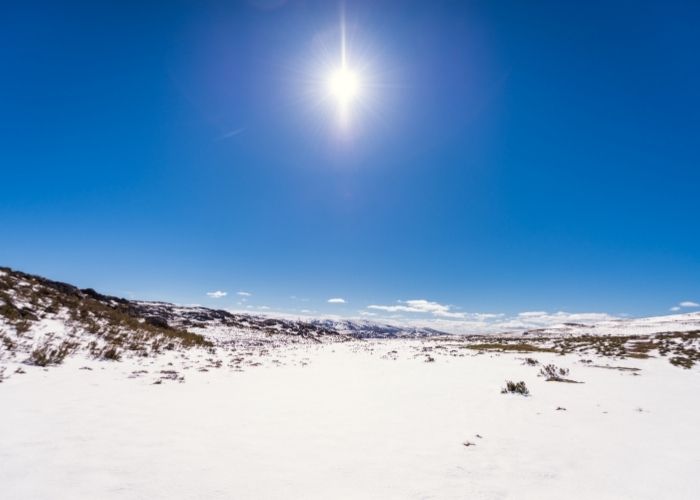WEATHER – After the year began with temperatures well above normal for January, on Epiphany this spring-like mood comes to an end in Spain. Winter is returning and temperatures are dropping to values appropriate for the time of year.
Especially the north will have to deal with a rain front according to the forecast of the Spanish weather service AEMET. The arrival of this polar air will cause a “marked” drop in temperatures throughout Spain. And we will feel temperatures 10 to 15 degrees lower than in recent days. Thus, starting from Wednesday, thermometers in the northern half will reach temperatures typical for the month. Or perhaps even be ‘slightly colder’, according to AEMET spokesman Rubén del Campo.
With this, night frosts will return to large parts of the interior. Meanwhile, daytime temperatures will generally not exceed 15 degrees Celsius,’ according to del Campo. In addition, on Tuesday and Wednesday, rain will move across Spain, especially in the north. And that means that events such as the Three Kings Parade could be cancelled’.
From hot records back to cold
This weather change comes after temperatures in Spain in the last days of 2021 and the first days of 2022 were the highest since records began. Maximum temperatures were up to 6 degrees higher than normal for the time of year. Moreover, they matched the temperatures normally reached in Spain in late April or early May.
Monday saw an anticyclonic and dry atmosphere, with a rain front in the afternoon on the western side of Galicia. There were fog banks in the valleys of the major rivers and strong winds in Galicia and the Cantabrian Mountains. Furthermore, temperatures dropped slightly, but at 10 to 15 degrees were “still very high for the time of year”.
Changes on Tuesday
From Tuesday the situation changes, with the arrival of polar air from the Atlantic, which coincides with a new front, Meteored predicts. Winds will be strong in the north and at the Mediterranean Sea. And precipitation will move from west to east with snow limits dropping to 1,000 metres in the north and 1,500 metres in the south. Therefore, the Pyrenees in particular will see heavy snowfall.
Temperatures will drop “considerably”, and will be “very noticeable” especially in the western part of Spain. However, in the regions around the Mediterranean Sea, for example in the Valencian region, temperatures could rise to 25 degrees. In the area around the Cantabrian Sea, it also stays warm, with maxima above 20 degrees. Temperatures drop in the west and in cities such as León, Valladolid and Madrid they reach between 10-12 degrees.
Rain in Galicia
On Tuesday the rains will mainly affect Galicia, where they may be accompanied by thunderstorms. And in Cantabria, while during the day the rest of the peninsula will be cloudy, there could be thunderstorms here also. Furthermore, there will be ‘very powerful’ gusts in the mountainous areas, on the coast and in large parts of the northern plateau.
Epiphany Eve
Tomorrow (Wednesday), the eve of Epiphany, the wind on the peninsula and the Balearic Islands will be from the west and northwest. The wind blows “with intensity”, both in the Mediterranean and in the mountainous areas of northern Spain.
A new rain front is approaching the peninsula, especially Galicia, eastern Cantabria and the Pyrenees. In Castilla y Leon, in the Iberian system and the mountains of the south-east, precipitation is “weak and scattered”. In Extremadura and the western half of Andalucia, it will rain by the end of Wednesday, according to Meteored.
Snow and cold
Meanwhile, the snow line will drop a little further, to around 900 metres in the Pyrenees. And also between 900 and 1,200 in the rest of the northern half. Furthermore, in the southern half, the snow will remain above 1,200 metres.
Temperatures will drop, especially in the Cantabrian Sea, the central zone, the east of the peninsula and the Balearic Islands, by six to ten degrees compared to Tuesday. In addition, the drop in some areas of the far north and eastern third could exceed ten degrees compared to Tuesday, an “extraordinary drop”.
Much of the far north and east will experience frost, and during the day the atmosphere will be cold with maximum temperatures in the two high plains of around 5 to 10 degrees; 10 to 15 degrees in the Cantabrian region, the interior of Andalucia and Extremadura; and between 15 and 18 degrees in the Mediterranean regions. Del Campo stressed that temperatures across the country are “normal” for this time of year, although they are “slightly lower than normal” in northern Spain.
Winter Epiphany
Especially early in the morning, it will be very cold, with temperatures below zero in much of the peninsula’s interior. It could even freeze by a degree on the Basque coast, such as in Bilbao,’ warned Meteored spokesman Samuel Biener.
In the cities of Teruel and Soria it can be minus 6 degrees and in Madrid, Salamanca, Zamora, Huesca, Pamplona, Vitoria, Lleida and Palencia the temperatures are between minus 3 and minus 5 degrees. In Andalusia it will rain but around the Cantabrian Sea and in the western half the temperatures will rise.
Thursday back to ‘normal
Thursday will bring occasional showers in Galicia, Cantabria and the Pyrenees, but otherwise it will be a ‘stable day, with few clouds and rain in the rest of Spain. The snow level will drop a little more on Thursday in the Pyrenees, to 700 metres, while in the rest of Spain it will rise from 1,000 and 1,200 to 1,400 metres.
Winds remain strong in the northeast of the peninsula and the Balearic Islands, as well as in parts of Cantabria, said the AEMET spokesman, who also predicted that weekend will likely be dry. Night frosts may persist, although the “general” trend will show an increase in temperatures, but with “values typical of the time of year”.


